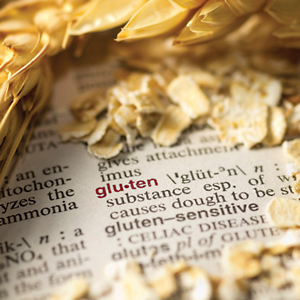 Surely you’ve seen gluten-free foods at the grocery store. The words are on shelf signs and food labels, not to mention on the menus at many of your favorite restaurants. Is all this talk about gluten in the same category as eating vegan, organic, or any of the other new diet trends to which our families are constantly exposed?
Surely you’ve seen gluten-free foods at the grocery store. The words are on shelf signs and food labels, not to mention on the menus at many of your favorite restaurants. Is all this talk about gluten in the same category as eating vegan, organic, or any of the other new diet trends to which our families are constantly exposed?
If you asked that question of Alesha Schwarzchild, she would share with you her nine-year-old son’s reaction to gluten – severe stomach pains, cramping, and diarrhea. “People just don’t realize how much impact this can have. One piece of bread, one cookie – given with the best of intentions – can cause him days of pain.”
Gluten is a protein found in many grains including wheat, barley and rye. Juan Villalona, MD, a pediatric gastroenterologist and medical director of the Gluten Intolerance Group of Richmond, says that food allergies are different from food intolerances. A food allergy might present symptoms involving skin, lungs, and the anaphylactic shock some people experience (from peanuts for example). But food intolerances can create a wide spectrum of reactions. In the case of gluten intolerance, diarrhea, acid reflux, stomach pain, and a specific kind of skin rash can all be symptoms. Celiac disease is a permanent form of gluten intolerance with serious, long-term consequences to the intestinal tract. However, it’s important to note that you need to eat gluten-free only if you have either celiac disease or gluten intolerance. Taking gluten out of your diet or your child’s diet serves no purpose unless you or he are one of those people who react to it.

Schwarzchild’s son Owen was born with what was diagnosed as colic. Despite the fact that he was breastfed, he had frequent stomach pain, vomiting, and diarrhea. His pediatrician prescribed the antacid Xantac. But as these symptoms continued, Schwarzchild, a registered nurse, was deeply concerned. She took him to numerous doctors, but none was able to diagnose or treat Owen’s problems with any success. As the years went by, he was not developing physically and was consistently in only the tenth percentile on the growth charts, a condition physicians call failure to thrive. In addition, he had problems with hyperactivity and asthma. When Owen was nine years old, searching for help with his asthma, Schwarzchild took him to Kimberly George, MD, a Richmond allergist.
Dr. George suggested that the family keep a food diary for a week. What did Owen eat? How many bites until full? When did his stomach hurt? When did he have acid reflux? His food allergy tests were all negative, but food allergy tests are often unreliable. Dr. George determined that many of his symptoms were from foods he was reacting to including gluten. Owen was finally diagnosed with celiac disease. Schwarzchild says, “It just does not occur to pediatricians to look for gluten intolerance or celiac disease.”
On a gluten-free diet, Owen began to thrive. He gained weight and height and his stomach pains were finally gone.His asthma became controllable. “The most pivotal thing happened two weeks after the diet began. We ate out and he evidently ingested some gluten…he had terrible stomach pains, a huge reaction,” Schwarzchild says. “That’s when I knew positively that he had celiac and how important this was.”
Wendy Hayden of Powhatan has a similar story. Her son Nathaniel, five, was also born with severe colic. As he grew, he continued to have stomach problems including stomach pain and diarrhea. It seemed that every time he ate he was in pain
Finally, Hayden took him to UVA Medical Center where he was given IgA and IgG tests for identifying autoimmune disorder. This led to a positive diagnosis of celiac disease. On a gluten-free diet, Nathaniel’s life turned around. Says Hayden, “He is much healthier and happier now. It was difficult to get others [friends, relatives, and the school] to understand the importance of Nathaniel’s diet. But, as a mother you have got to take it seriously and get others to accept it too.”
Dr. Villalona, says the gold standard for celiac is the presence of villi blunting and leucocyte infiltration in the intestines. This can be determined through endoscopy and biopsy, an invasive procedure for a child. According to the specialist, there are blood tests, but they can be unreliable, especially if the child being tested has not eaten gluten for a while. And, the tests are only for celiac disease; there are none for gluten intolerance.
Many families will opt to remove gluten from the child’s diet completely for at least ten days and record the child’s reaction both off it and when it is reintroduced. But the diet must be precise, as in many cases, even the smallest amount of gluten can cause a big reaction.
No small task, this complete removal of gluten, but it’s important. Kristin Hunold lives in the West End with her family.She has celiac disease, as do her son and younger daughter. Her husband and older daughter do not. “It may seem overwhelming at first, but it’s really not such a big deal [eliminating gluten],” she says.“My kitchen is totally gluten-free, but because my husband does not have celiac and wants his own traditional foods, I have a separate table, toaster, dishes, and pans for making foods that contain gluten.” Many people completely separate the gluten-free areas of their kitchen. Breads, cereals, and fl ours containing gluten can cause cross contamination. Hunold underscores that using separate pots and pans is a good idea. Even when cleaned, these items can retain trace amounts of gluten.
Gluten intolerance and celiac disease are serious disorders. If ignored, the individual loses the ability to properly digest other foods. Nutritional deficiencies, osteoporosis, lactose intolerance, neurological complications including depression, short stature, and increased risk of cancer, particularly lymphoma, are all possible results. While the effects of gluten intolerance can be remediated, celiac disease is irreversible.
Are gluten intolerance and celiac disease becoming more prevalent? Dr. Villalona says that in the past in his practice, he saw perhaps five new patients a year with celiac disease. He now sees about twelve to fifteen per year, some as young as six months old. Last year, Mayo Clinic researchers reported results of a research study that showed that celiac disease is four times more prevalent than it was in the fifties.
Nathaniel’s mom says gluten intolerance and celiac disease are important health issues, especially when it comes to children. “Please take this seriously if you are a mom with a child with this disorder or a teacher in the schools. It has very serious long-term consequences. Empower your child to say no to things that will harm him. My family now understands this but many others don’t.”
Going Gluten-Free? Strategies for Families

While two major chains, Martin’s and Kroger, both have lines of gluten-free foods, a much larger selection can be found in health food stores such as Whole Food Market, Ellwood Thompson’s, and Good Foods Grocery.
Kristin Hunold of the West End also recommends Wegmans in Fredericksburg. She’ll head north for a once a month stock-up on products she uses in quantity. “I prefer to shop at Wegmans, not only to save money, but because they label all their store brand foods very clearly if they are gluten-free as well as for many other allergens,” Hunold says. This parent, whose son, Thomas, was the first to receive a celiac diagnosis ten years ago, says Wegmans labels it all, “right down to the milk and meats,” making it very easy to shop, especially for beginners who are just starting their gluten-free journey.
To save money, and give her family the widest choice of foods, Hunold makes a great deal of her own breads, pastas, and cakes.
Don’t want to cook? Two Richmond bakeries, AnnaB’s in Glen Allen and 3 Fellers in Goochland, are dedicated entirely to gluten-free products. Others, including Cary St. Cupcakes and Pearl’s Cupcakes have gluten-free lines.
Eating out can be tricky. French fries are sometimes rolled in wheat flour before cooking. Many Chinese dishes include soy sauce in their recipes, which is made from wheat. You cannot be sure unless it says gluten-free on the menu or label. Many restaurants now have gluten-free menus. Maggiano’s offers gluten-free pasta; P. F. Chang’s is another choice for families. Craving pizza? Bottoms Up Pizza, Uno’s Chicago Grill, Frank’s Ristorante’ Italiano, Fresca on Addison, Stuzzis, and Flames are some of the restaurants in Richmond that serve gluten-free pizza. Some chains make the claim, but complaints have been lodged that products are not reliably gluten-free.



